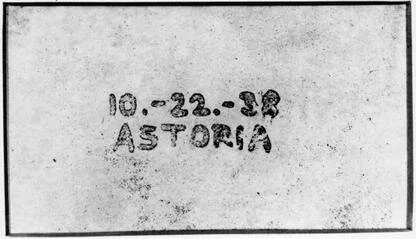The whole country copies the birthplace of Xerox
/Carlson’s first successful photocopy was of the words “10.-22.-38 ASTORIA.” Photo courtesy of the Xerox Corporation.
By Jonathan Sperling
There are at least a dozen copy shops throughout Astoria today, but the most important photocopying operation started 81 years ago in a small room on 37th Street.
It was in that room, located on the second floor of a home at 32-05 37th S., that Chester Carlson first developed the process of dry photocopying, which didn’t rely on liquid chemicals to make a duplicate copy. On Oct. 22, 1938, Carlson successfully photocopied the words “10.-22.-38 ASTORIA” using the technology, known as “xerography” or Xerox.
On Monday, local officials joined Xerox representatives and Carlson’s family members to co-name the corner of 37th Street and Broadway “Chester Carlson Way.”
“The technology revolution started right here in Queens, when Chester Carlson made the first modern photocopy right here in Astoria,” said District 22 Councilmember Costa Constantinides during the co-naming ceremony. “Astoria may have changed in the 81 years since it was Xeroxed into history, but today we paid permanent tribute to the transformation that started right here in western Queens.”
A street corner in Astoria now bears the name of a Xerox co-founder. Photo courtesy of Councilmember Costa Constantinides’ office.
Though his main residence was in Rochester, Carlson attended Manhattan’s New York Law School beginning in the 1930s. While at law school, Carlson studied at the New York Public Library, where he copied information by hand from law books because he could not afford to purchase them. It was this experience that inspired Carlson to develop xerography technology.
Carlson’s early experiments, which at one point caused a sulfur fire, upset his wife, leading him to rent the room on 37th Street from his mother-in-law. He hired an out-of-work physicist as an assistant and converted the room into a makeshift laboratory.
A researcher for the Haloid company, which manufactured photographic paper, read an article about Carloson’s experiments and saw it as a way to compete with Kodak; the company later signed a contract with Carlson.
In 1948, 10 years after Carlson made his first photocopy, the Haloid Company made its first public announcement of xerography. The next year, it launched the first commercial photocopier: XeroX Model A Copier.
Carlson’s innovative process eventually led to the creation of the revolutionary Xerox 914 in 1959, which paved the way for a long line of Xerox photocopying machines, many of which are still in use today.
Carlson, who died in 1968, did not stay in Astoria, but his legacy lives on along 37th Street.





